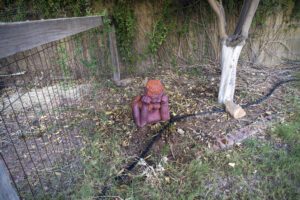Interview by Daniel Mariotti
Photos by Daniel Mariotti
I met Vanessa on a Thursday, after work. It was a long day. I was really unsure how this was going to go. But Vanessa is one of those people that you enter their bubble and any stress or fatigue kind of goes away. She’s a friend who has a lot of sympathy for others and I felt a calm pass as she watered her plants. Free of mental agitation. Unrelated, Vanessa is cursed/really bad with technology. That’ll be important later.
BA: Who’s name is Hope?
Vanessa: It’s a great aunt, my dad’s great aunt maybe, so my great great aunt, and she lived right down the street from Casey Moores. Along with the rest of my family.
BA: What’s your background in?
Vanessa: I have a BFA in Ceramics and a BFA in Small Metals from ASU, but also I have been a lifelong amateur photographer, and lover of food and travel. But I got to ASU and took all these art classes that I didn’t even know existed like sculpture and jewelry or foundry, small metals, you know all this new stuff. I ended up overburdening myself with nothing to show for really. Like I had all these new “kind of” skills, jack of all trades master of none. It’s fascinating to me that people can decide on one thing and hone in on that skill and their work really showed it. And then I look at my stuff and I’m like…shit.
BA: What’s the foundry story?
Vanessa: So to get the small metals degree I had to take blacksmithing and that is only offered one semester and they fill up really fast. So I procrastinated like normal and didn’t sign up in time and it was full. So I panicked and looked at a class that said forging which is essentially the same thing. I signed up for it and the day of, I was like “why is this in the sculpture building???” And one of the girls I knew from the small metals was there and I asked is this forging? And she looked and said “you mean foundry?” I looked down at my paper and sure enough it said foundry and I accidently took a foundry class, fell in love with it, and it changed my life. I also met Mary Neubauer who then got me the job at Bollinger. I met so many lasting friends through the foundry class.
BA: How did your work change whilst you were in school? And how has it changed since leaving?
Vanessa: My main expansion in my last 4 years of school was “medium”. I really didn’t push “subject”. I concentrated mainly on learning new “tools”. I have done very little of my own work since leaving school I’ve done some found object memorial pieces that I call my “collections”.
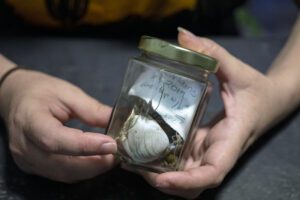
BA: What are the collections about?
Vanessa: I collect things when I go on trips or backpacking or hikes. They’re little memory jars. I put notes in them because I don’t remember things. I really love to take pictures but that ends up sitting in the camera and only I will look at the 5 million pictures that I took. Nobody else cares about every step I took in France you know, so this is a more tangible way to do. I can touch them and feel them and smell them and it’s just more fun.
BA: How long have you worked here and what was your first day at the Bollinger Atelier like?
Vanessa: I have worked for BA for 6 years. My first day was exciting and scary as hell. I was working on the 30 ft. tall Walking Figure, the foot. I was dressing the seam line of the foot of that. A couple days later it accidentally fell off the desk and smashed into a bunch of little pieces on my first week.
BA: Who taught you wax working?
Vanessa: Bee and Ron. In the beginning it was hard. The work itself isn’t hard, learning what to look for is hard. Like, they would say “I can still see the seam line” or “I can see you created this pattern and it doesn’t match this pattern”. So to me it was training my eye to see what they saw and learning the correct thickness just by looking at it or feeling it. Being able to look at the wax and tell you the temperature, I can’t tell you if it’s 180 degrees but I can tell you if it’s too hot. Ron’s pretty close at being able to tell you what the temperature is.
BA: What was one of your favorite things to start learning?
Vanessa: Gating. We still really discuss the gating systems but I can look at a piece now and know how it’s going to get gated. That took a very long time for me, I’m kind of slow anyway and it takes a while for me to be comfortable and be confident. But that confidence is there now and I can look at a piece and be able to do it. I used to be completely lost and not know how to gate it whatsoever; it literally took me two years to be confident that it’d work without them coming by and telling me to change it.
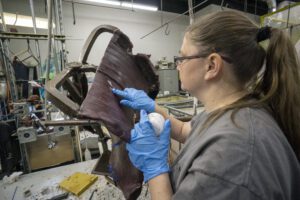
BA: How is it complicated?
Vanessa: The gating system is the circulatory system for the metal to go in and air to come out. But I wasn’t really understanding that because at ASU they teach a completely different system, they use a direct system, Bollinger uses an indirect system. Like when you add a vent to something it’s not just venting it’s pulling the metal to that spot. Metal is going to find the path of least resistance. And it can completely bypass something sticking out. If there’s a vent over there it will suck it that way to fill it. That took me years to understand. When I’m training the other girls now I try my very best to explain why we do these ridiculous things. Even if they don’t understand completely they start to hear, “Oh, it’ll draw the metal this way,” or “it’s going to vent, this is really thick it’s going to feed” and understand these words and what they actually mean instead of throwing these words at them which mean nothing to them until they can relate to it.
BA: What area in the gating system can be changed most?
Vanessa: The big major feeds are generally the same. Like we look at a piece and we know they have to be fed from the bottom in these thicker areas. The improvements usually come from feedback from the pour that a place is shrinking or it’s not filling. We try to take into account the steps after us, for instance if we cut something in a way that will cause the shell to pool we’ll cut it differently next time so it drains better, but also thinking about how it’ll flow in pour and also how the metal guys can fit it back together.
BA: What art do you most identify with?
Vanessa: I tend to be more of a traditionalist in my tastes. While “monumental” and figurative sculptures themselves may not be cutting edge, the incredible talent and skill that goes into them is very inspiring to me. I gravitate towards that.
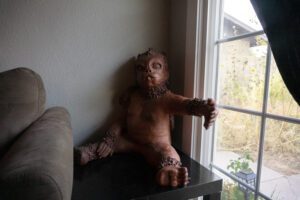
BA: Do you have a different attitude about art by working here?
Vanessa: I have a lot more respect for artists who make their own work and the behind the scenes people. I am trying very hard to open my heart to modern art. I think I’m a little more practical and more rigid in my thinking than I think I am, so it’s hard for me to see a strange blob and see the art in that.
BA: Do you think it blends well with furniture?
Vanessa: I do. It seems to fit. Misha Kahn has definitely opened my eyes to that. They’re fun, they’re whimsical.
BA: How much propane do you go through a week?
Vanessa: Did Tom put you up to this question? I can’t say. Easily two bottles.
BA: What jobs have you done other than being an artist?
Vanessa: A ton of customer service, flower delivery, food service, plant nursery and photographer.
BA: What is your dream project?
Vanessa: I really would like to make a large scale piece of my own. It’d be fantastic. It’d be great to work on one of my weird creatures in metal. If I could go back and redo it I would be into building sets. Take the skills that I learned from working at Bollinger, the sculpting skills, the building skills, the tools, the little bit of mold making stuff that I’ve learned. I’d love to go into set design and working on movies and shows like the Dark Crystal. Shows that they are actually choosing to build amazing sets instead of using CG, going in and creating amazing worlds from scratch would be incredible. Like the world of Lord of the Rings, Hobbiton? That would be incredible. It would combine my love of plants and art and beauty and building and sculpture all together in one. That’s the dream. I don’t know where you would learn all those skills, film school maybe?
BA: So you grew up in Egypt?
Vanessa: My dad’s an architect and took us there to grow up. I was surrounded by history and magic and culture and food. And then I had to move back here and it was devastating. It took me a long time to appreciate here.

BA: Do you think that’s why you like cats?
Vanessa: No I liked cats before Egypt too. But they’re a good reminder.
It was an incredible foundation and place to grow up. I love scary things, I love history, I love dirty grimy beautiful big polluted, populated cities full of people, chaos, and noise and Cairo is all of those things.
I was lucky to grow up in a household that was always supportive of my art in any form that it was. They never once said to me, “oh, what are you going to do with that degree?” The only thing they did say was that I didn’t have to go to school to do art. But school meant a lot to me and I’m so thankful I did it. I wouldn’t have had this job. I didn’t know what form my making art was going to take, but I was always going to be in the arts no matter what. First and foremost, though, I was going to be happy. I will not work in an environment that makes me unhappy. I will not go to a job that makes me unhappy. I won’t sit in a cubicle and sit at a computer.
BA: Speaking of which what’s up with you and computers/technology?
Vanessa: I don’t know man, it’s just… So my mom was the computer teacher.
BA: COME. ON. SERIOUSLY?
Vanessa: I know, I know. So because I was a spoiled only child, I refused to learn from her. She was teaching us typing without looking at our fingers and I didn’t like it just because it was my mom’s class. Some mother daughter garbage, so I never really learned. I still have to look at my fingers when typing. As far as electronics not working for me, I think I put it out in the world that it’s not going to work and I’m really good at creating my own reality for better or for worse. And I mean you’ve seen it.
BA: Sure.
Vanessa: You did the same exact thing I did and it worked for you and not for me. Ron sees it every day with the phone.
BA: Do you feel like you need to learn it?
Vanessa: Yeah I think I should, but I know myself and I’m stubborn. I don’t even own a computer so how am I going to learn? I would love to manipulate pictures, I love taking them I’d love to learn how to do something with them.
BA: What are some of your favorite quirks in the wax department?
Vanessa: We have a troll goblin named Inges who lives in the wax room and steals and hides shit from us. I’m not even kidding. Lives there, he sabotages us. He steals our tools. You will take a mold apart and set all your washers and nuts down, on the floor, not like they are falling and spinning away; you’ll put it back together and two of your washers will be gone. Years ago I found a little troll goblins online and made Christmas ornaments for Ron and Marta. Ron’s hangs in the wax department and he’s sitting on a pile of nuts and washers. He’s kind of our effigy.
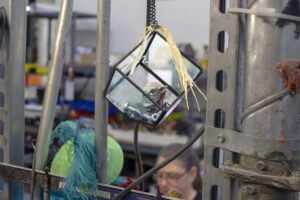
BA: So internally the wax department is known as the weird murder area. What podcasts are currently in rotation?
Vanessa: Cold case files which is exactly what it sounds like. My favorite is Weird Darkness. And Spooked is only this time of year and it’s the best podcast ever. It’s scary stories. I love scary stories and ghost stories and murder, what can I say, I don’t know.
BA: Who started doing that tradition?
Vanessa: The murder tradition?
BA: No the podcasts.
Vanessa: Oh probably Bee and Ron. They were already listening to varieties of; well it was less murder, maybe no murder. I might have had an effect on the darkness of what we are listening to. But Ron and I evolved it to that together. But in our defence it’s Halloween for the next three months and I’m obsessed.
BA: Do you think being an artisan is as valuable and rewarding as it is being the artist?
Vanessa: Absolutely. I think I’m suited for it. Because I’m lazy, I wouldn’t be making my own art, I’d be driving flowers around. Being an artisan has allowed me to fulfill that drive to make art and be around artists. I realized that’s one of the most valuable and rewarding parts of my job is to be around you guys. Because we’re constantly being creative together. I love it. I’m definitely suited for this.
BA: Top 5 places you recommend people to travel to?
Vanessa: Depends on them but, go to Mexico, it’s right there, it’s incredible, incredible food, incredible people, incredible history, Rocky Point does not count.
BA: Incredible digestive problems.
Vanessa: Rocky point does not count.
Canada. Go to Egypt. We’ve all been interested in ancient Egypt, go see it. It’s expensive to get there but once you’re there it’s cheap. Don’t be afraid, people are afraid of everywhere. Go to France, best food you’ll ever have ever. The food is the richest most decadent; how Americans treasure power and money, the French have spent the last thousand years really enjoying the good life. Food and each other and wine. Go to India. Also food. And then go to Iceland. Because I’ve never been there. People also don’t travel because it’s too expensive but don’t think about that, just buy the plane ticket and the money will come I promise you.
BA: I have this on tape you know, if I do this and the money doesn’t come just know I’ll be stuck in a different country and there will be no repercussions other than a strongly worded postcard to you from me.
